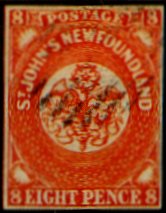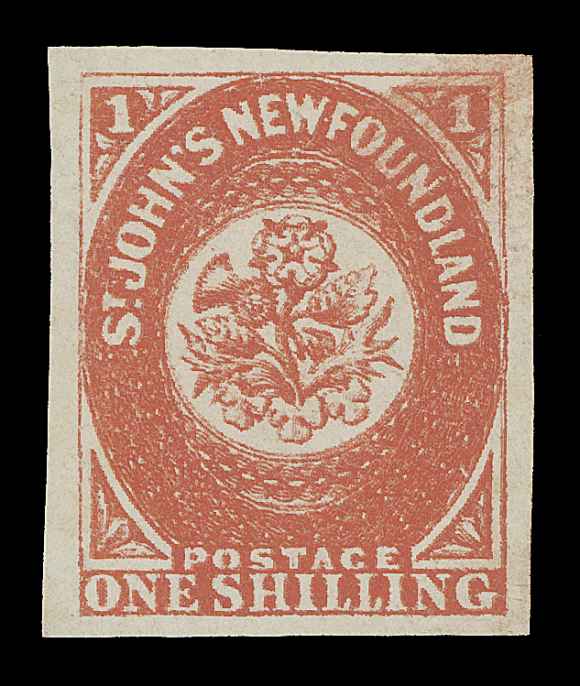

(Genuine)
Return To Catalogue - Forgeries of the second issue, 2 p, 4 p and 6 p - Forgeries of the first issue - Newfoundland - Canada
Note: on my website many of the
pictures can not be seen! They are of course present in the cd's;
contact me if you want to purchase them: evert@klaseboer.com.
Many of these stamps exist bisected on cover. But these bisected stamps also have been forged. For example by the forger Raoul de Thuin; see 'The Yucatan Affair, The work of Raoul Ch. de Thuin, Philatelic Counterfeiter', published by The American Philatelic Society.
Distinguishing characteristics of this forgery:


(Dist. char. 3 and 4)
1) The stamp is engraved
2) There is no dot in the 'H' of 'HALF' as in the genuine stamps
3) The 'G' of 'POSTAGE' looks like a 'C'
4) Apostrophe in 'JOHN'S' has no comma-like tail
5) The rose sometimes touches the inner circle at the top.
Distinghuishing characterisics of this forgery:

(Dist. char. 4a and 4b)
1) The forgery is a photolithograph
2) The lines in the design are thicker, so the white spaces are
less
3) Guide dots are sometimes missing
4) Some errors and corrections:
.......a) a dot in the 'S' of 'SIX'
.......b) a dot in the right lower leg of 'X' of 'SIX'
.......c) the frame is broken below the 'F' of 'HALF'
.......d) in 'PENNY' there are dots between 'P' and 'E'
.......e) in 'PENNY' there are dots between 'N' and 'Y'
5) Generally, a 10 bar grid is used as a cancel

(genuine stamp)
I presume that the above stamp is the forgery described in Album Weeds.
Distinghuishing characteristics of this forgery (taken from Album Weeds):
1) A dot in the lower part of the left side of
the 'O' of 'POSTAGE'
2) A scratch across the middle of the 'E' of 'POSTAGE'
3) A small dot in the upper part of each limb of the 'U'
4) A small flaw in the top edge of the last 'D' of 'NEWFOUNDLAND'
5) A small scratch going outside the frame, bleow and to the left
of the 'S' of 'ST'
This forgery is engraved as the genuine stamp.
In my opinion, in many of the Oneglia forgeries I've seen, the 'N' of 'PENCE' has a very short right leg compared to the genuine stamps. However, the second forgery shown here does not have this characteristic.
Sperati seems to have made two(?) forgeries of this stamp. They are not described in the BPA handbook on Sperati forgeries. I have no further information right now.
Another forgery:
I have no further information on the forgery above, except that it is a forgery.
I don't know the distinguishing characteristics of this Oneglia forgery. I've seen it cancelled with a circular cancel consisting of parallel bars; also with a 'N35' numeral cancel.
Sperati has made three different kind of forgeries of this stamp, Reproductons A and B are known in die-proofs, Reproduction C is known in used and unused condition.




Reproduction C. The cancel 'ST JOHNS NEWFOUNLAND PAID FB 5 1859'
was also forged by Sperati.
In reproduction A:
1) there is a dot in the lower part of the 'J' of 'JOHN'
In reproduction B:
1) The 'O' of 'JOHN' is irregular at the top
2) A small break in the frame above the 'W' of 'NEW' can be found
3) The right top of the 'N' of 'NEW' slopes diagonally to the
rigth (instead of being cut square)
4) The top of the 'L' of 'LAND' is rough
5) A small smear can be found on the right leg of the 'N' of
'SHILLING'
In reproduction C:
1) A doubling of the letters of 'POSTAGE'
2) A dot in the right of the 'H' and the top of the 'S' of
'JOHN'S'
3) A dot in the top ot the 'O' and a coloured spot in the cheeck
of the first 'D' of 'FOUND'
4) Two dots in the 'O' and one in the 'S' of 'POST'
5) The bar of the 'A' of 'POSTAGE' is weak and sometimes missing
6) A dot in the upper diagonal of the 'N' of 'SHILLING' and a
heavy dot in the right leg.
A Senf forgery with overprint 'FALSCH!' (= forged in German).
This forgery was given as a 'KUNST-BEIGABE' to the Illustrirten Briefmarken-Journal of 1 June 1884, together with a genuine Helgoland cut out postcard.
A whole sheet of Oneglia forgeries, printed in rows of 6, all six values below each other:

(Reduced sizes)

Sperati forgeries (blackprints) and forged cancels.
Some genuine cancels on genuine stamps exist, but with the cancel applied after the stamps were invalid. The cancel used is shown below. The '9' was inverted to become a '6' in '1864'. They were produced in the 1940's. The most common ones are St.Johns, but Grand Falls also seems to exist. They are sometimes accompagnied by a mute line cancel (as in the second example). Source: http://www.easternstamps.com/images%5CPublication_FLd.pdf. I've seen several dates. Some examples of these forgeries:

A Raoul de Thuin forgery, the Crepusfund cancel, the 'D3c' cancel
and the 'More To Pay' were all forged by him.
Stamp forgeries - Timbres-Poste faux - Briefmarken Fälschungen